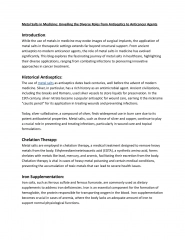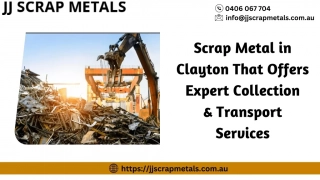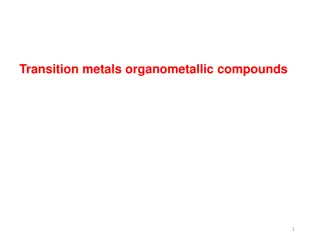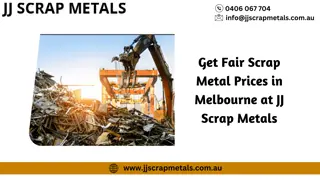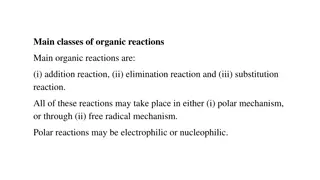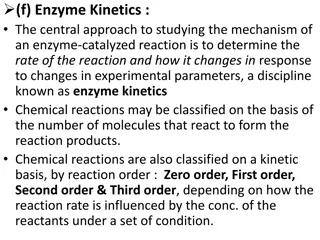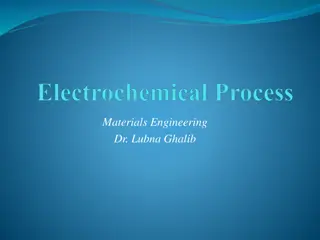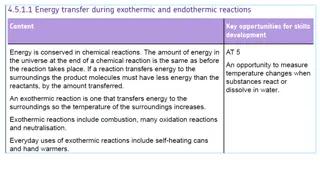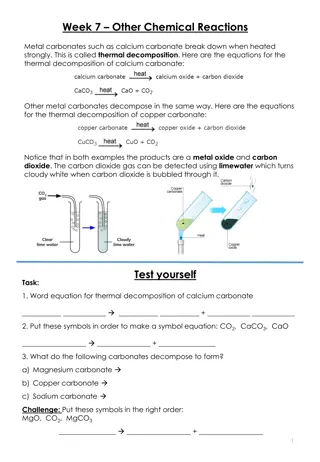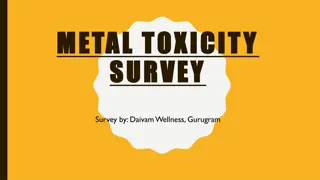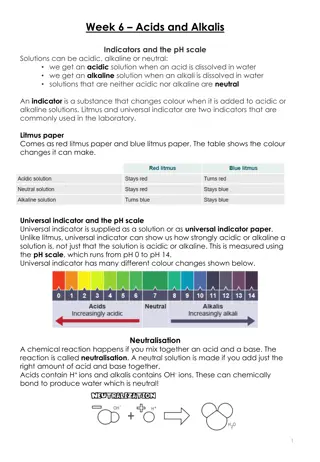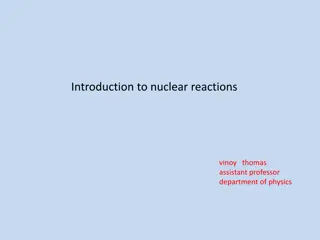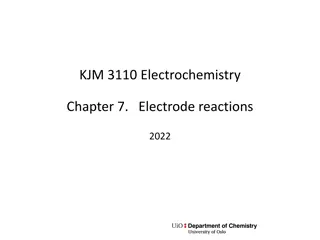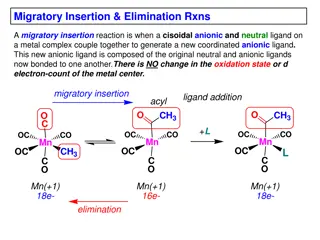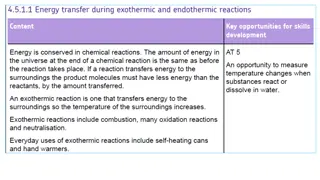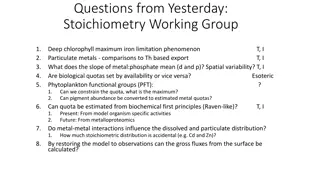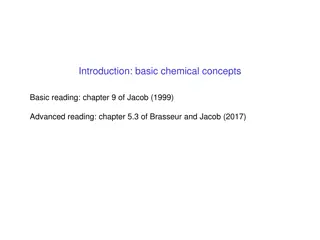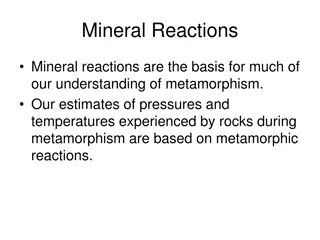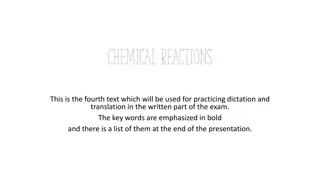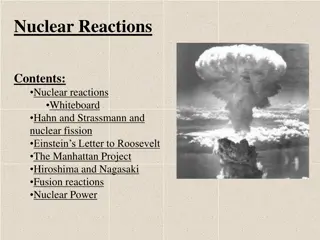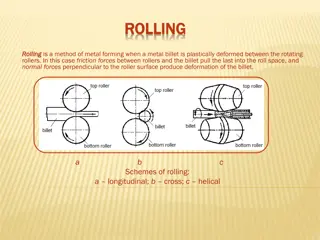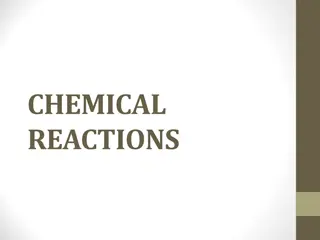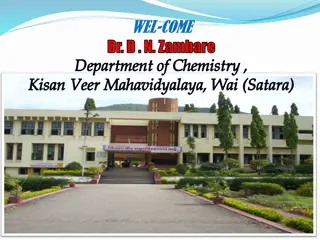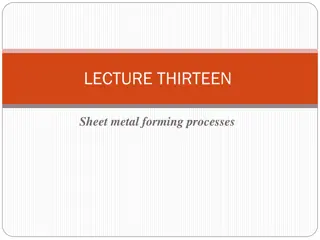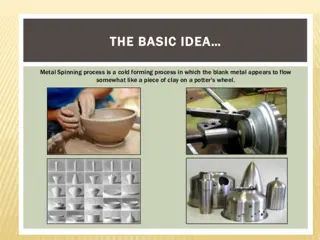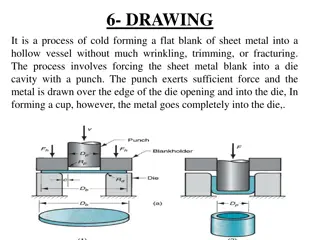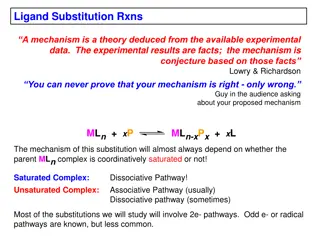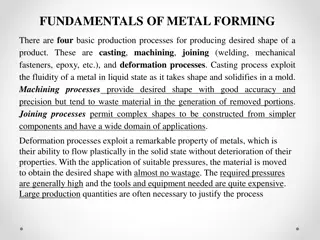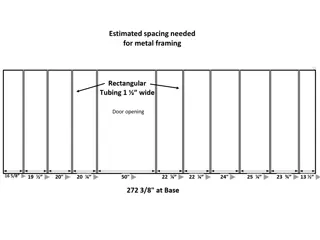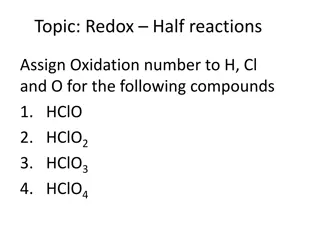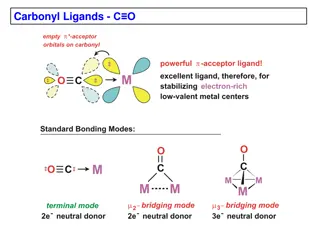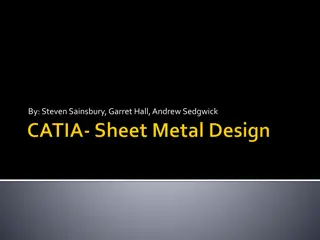Metal Salts in Medicine_ From Antiseptics to Anticancer Agents
While the use of metals in medicine may evoke images of surgical implants, the application of metal salts in therapeutic settings extends far beyond structural support. From ancient antiseptics to modern anticancer agents, the role of metal salts in medicine has evolved significantly. This blog expl
9 views • 3 slides
Scrap Metal in Clayton That Offers Expert Collection & Transport Services
JJ Scrap Metals, located in Clayton, offers professional scrap metal collection and transportation services. With a team of experts boasting extensive industry knowledge, we assure you of maximising returns for your metals. Our goal is to provide efficient and reliable services, making it convenient
6 views • 4 slides
Organometallic Chemistry (CHEM 42 1)
Organometallic chemistry delves into compounds with carbon-metal bonds, merging concepts from inorganic and organic chemistry. The field encompasses diverse compounds like ferrocene and tris(triphenylphosphine)rhodium carbonyl hydride, with nomenclature based on naming organic groups and adding meta
1 views • 13 slides
Transition Metals Organometallic Compounds Overview
Transition metals bonded with organometallic compounds like metal alkyls, aryls, and hydrides are common in chemistry. Ligands are crucial for stabilizing these complexes, with carbon-based ligands exhibiting diverse binding modes based on the metal's hybridization state. Preparation methods for tra
1 views • 25 slides
Overview of Serious Adverse Reactions and Transfusion Events
This data compilation covers the reporting trends, breakdown of reports, components issued, and specific types of adverse transfusion reactions experienced within the National Healthcare Organization (NHO) from 2019 to 2022. The information includes statistics on Serious Adverse Events (SAE), Seriou
2 views • 46 slides
Maximise Returns on Metal Recycling with Affordable Scrap Metal Prices
In today's eco-conscious world, JJ Scrap Metals stands out as a beacon of sustainability and profitability in the scrap metal industry. With a proud history of serving areas like Moorabbin, Dandenong South, Pakenham, and beyond, we're not just any scrap metal collector but your partner in ensuring t
4 views • 5 slides
Metal wall art
Elevate your living space with \"TheOnlyPlanetEarth\" metal wall art decor, curated to bring a touch of modern elegance to your home. Perfect for living rooms, this exquisite piece is available in Singapore, Indonesia, Malaysia, Dubai, Saudi Arabia, and Europe. Our services include outdoor metal art
2 views • 1 slides
Get Fair Scrap Metal Prices in Melbourne at JJ Scrap Metals
Scrap metal can negatively impact the environment if not managed properly, necessitating careful handling and recycling. \nAt JJ Scrap Metals, we have the expertise to recycle tons of used metals, including copper, aluminium, brass, lead, batteries, iron, wrecked cars, and vehicles. \nAs Melbourne's
2 views • 5 slides
Metal Gates and Fence Installation Services
Metal gates are an excellent choice for enhancing the security and aesthetic appeal of your property in Redmond. At Electric Metal gates in Redmonds, we specialize in the design, fabrication, and installation of high-quality metal gates tailored to meet your specific needs. Our metal gates come in v
4 views • 3 slides
Metal Roof Painting of Factories At Commercial Painting Services
Commercial Painting Services has years of experience dealing with metal roof painting clients that have neglected their metal roof maintenance. \/\/ \/metal-roof-painting-michigan-ohio-indiana
1 views • 13 slides
Overview of Organic Reactions and Mechanisms
Organic reactions can be categorized into addition, elimination, and substitution reactions, occurring through either polar or free radical mechanisms. Polar reactions may be electrophilic or nucleophilic, while free radical reactions involve radicals reacting to complete electron octets. Different
2 views • 26 slides
Enzyme Kinetics for Understanding Chemical Reactions
Enzyme kinetics is a vital discipline focusing on the rate of enzyme-catalyzed reactions and how they respond to varying conditions. Reactions are classified based on reactant concentration influences. Zero, first, second, and third order reactions are distinguished, with examples like first-order r
0 views • 31 slides
Electrochemical Processes in Materials Engineering
Electrochemical processes play a crucial role in materials engineering, specifically in the context of corrosion. These processes involve both oxidation (anodic reaction) and reduction (cathodic reaction) reactions occurring simultaneously. Maintaining a balance between these reactions is essential
3 views • 22 slides
Energy Changes in Chemical Reactions
Exothermic reactions release energy to the surroundings, exhibited in processes like respiration and combustion. On the other hand, endothermic reactions absorb energy, demonstrated in examples such as photosynthesis. By observing changes in temperature and reactions between various substances, one
0 views • 24 slides
Chemical Reactions and Energy Transfers
Understanding chemical reactions involving thermal decomposition of metal carbonates, identifying exothermic and endothermic reactions based on energy transfers, and recognizing oxidation and reduction in redox reactions.
1 views • 5 slides
Metal Toxicity: Risks, Detection, and Impact on Health
Metal toxicity is a growing concern affecting many individuals today, with 41% of Delhi & NCR population testing positive for severe heavy metal toxicity. This survey by Daivam Wellness aims to create awareness about the dangers of metal toxicity and its impact on health, including diseases such as
1 views • 7 slides
Acids, Alkalis, Indicators, and the pH Scale
Solutions can be acidic, alkaline, or neutral depending on whether an acid or alkali is dissolved in water. Indicators like litmus and universal indicator help determine acidity or alkalinity. The pH scale measures this, with 7 being neutral. Neutralization reactions occur when an acid and a base re
0 views • 5 slides
Nuclear Reactions: A Comprehensive Overview
Nuclear reactions involve direct and compound scenarios, with direct reactions occurring in a short period and compound nucleus reactions leading to long-lived excited states. Different types of reactions like elastic scattering, break-up, and compound nuclear reactions are discussed, highlighting t
5 views • 11 slides
Electrode Reactions in Electrochemistry
Exploring electrode reactions in electrochemistry involves delving into Faraday's law, coulometry, and the importance of sustainable electrode reactions. These concepts help us understand how the quantity of charge passed affects the production or consumption of substances in electrode reactions. As
4 views • 27 slides
Insights into Migratory Insertion and Elimination Reactions in Metal Complexes
Migratory insertion in metal complexes involves the coupling of a cisoidal anionic and neutral ligand to form a new coordinated anionic ligand without changing the metal center's oxidation state or d-electron count. This process requires cisoidality between the reacting ligands and a vacant coordina
0 views • 19 slides
Energy Changes in Chemical Reactions
Energy changes in chemical reactions can be categorized as exothermic and endothermic. Exothermic reactions release energy to the surroundings, while endothermic reactions absorb energy from the surroundings. Examples and uses of both types of reactions are provided, along with details on measuring
4 views • 24 slides
Hypersensitivity Reactions and Classification
Hypersensitivity reactions occur in sensitized hosts following contact with specific antigens, leading to injurious consequences. The Gell and Coombs Classification categorizes reactions into Type I, II, III, and IV based on immune response and duration. Type I reactions are immediate and humoral, w
0 views • 30 slides
Insights on Biogeochemical Processes and Metal Interactions in Marine Environments
Delve into the intricate relationships between metals, stoichiometry, and biological quotas in marine ecosystems. Explore the impact of metal interactions on biogeochemical provinces, resource supply stoichiometry, and the constraints they impose on marine biota. Uncover how deep chlorophyll maxima,
0 views • 5 slides
Chemical Reaction Kinetics: From Unimolecular to Three-Body Reactions
Explore the fundamental concepts of chemical reactions, including unimolecular reactions like thermolysis and photolysis, bimolecular reactions, and three-body reactions. Learn about rate constants, reaction mechanisms, and the impact of pressure on reaction rates. Discover how energy transfer, phot
0 views • 9 slides
Mineral Reactions in Metamorphism
Mineral reactions play a crucial role in our comprehension of metamorphism, helping to estimate the pressures and temperatures rocks undergo. These reactions can be categorized as continuous or discontinuous, leading to different mineral products. Discontinuous reactions, exemplified by the transfor
0 views • 6 slides
Metal Detectorists and Antiquities Laws in Eastern Mediterranean
Post-Doctoral Research Fellow Dr. Samuel Andrew Hardy explores treasure hunting and metal detecting by detectorists from Sweden in Turkey, Greece, and Cyprus. The legal frameworks regarding metal detecting and excavation of archaeological sites differ in Cyprus, Greece, and Turkey. While unlicensed
0 views • 11 slides
Chemical Reactions and Catalysts
Chemical reactions involve the formation of new substances from reactants, with key processes like oxidation and reduction. Reversible reactions, endothermic and exothermic reactions, and the role of catalysts in speeding up reactions are explored. The significance of chemical symbols, formulas, and
0 views • 8 slides
Nuclear Reactions: Fission, Fusion, and Energy Release
This content covers various aspects of nuclear reactions, including nuclear fission, fusion reactions, the Manhattan Project, and examples of reactions involving different particles and elements. It explains concepts like exoergic and endoergic reactions, conservation of charge and nucleon number, a
0 views • 34 slides
Methods of Metal Forming: Rolling and Related Techniques
Rolling is a metal forming method that involves shaping metal billets between rotating rollers, utilizing friction and normal forces to deform the material. The process includes sheet rolling, slabbing, various sections of rolled metal, and different equipment used in metal forming. Other methods di
0 views • 5 slides
Energy in Chemical Reactions
Chemical reactions involve the release or absorption of energy in various forms like heat, light, sound, and electricity. Exergonic reactions release energy, while endergonic reactions absorb energy. Catalysts speed up reactions, while inhibitors slow them down without changing the amount of reactan
0 views • 8 slides
Chelation Chemistry: Structural Requirements, Ligands, and Applications
Chelation chemistry involves the formation of specific complexes known as chelates, characterized by ligands that coordinate with a central metal ion. This article explores the structural requirements for chelate formation, the role of chelating agents like EDTA and DMG, and the difference between m
0 views • 27 slides
Overview of Sheet Metal Forming Processes
Products made of sheet metals are prevalent in consumer and industrial applications, encompassing items like beverage cans, cookware, car bodies, and more. The primary sheet-metal processes include cutting, bending, and drawing, each serving different purposes in shaping sheet metals. Cutting operat
0 views • 6 slides
Metal Spinning Process and Techniques
Metal spinning, also known as spin forming or metal turning, is a metalworking process that involves shaping a disc or tube of metal by rotating it at high speed. This process does not involve material removal but rather the forming of sheet material over an existing shape. Hot spinning is a variati
0 views • 28 slides
Metal Drawing Process for Creating Hollow Vessels
Metal drawing is a cold forming process that transforms a flat sheet metal blank into a hollow vessel without wrinkles or fractures. By applying force with a punch, the metal is drawn into a die cavity to shape the blank into a cup-like form. This process involves setup similar to blanking but with
0 views • 19 slides
Ligand Substitution Reactions in Metal Complexes
Ligand substitution reactions in metal complexes involve the replacement of one ligand with another, impacting the coordination around the metal center. The mechanism of these reactions, associative or dissociative, is influenced by factors like coordination saturation and electron count. Experiment
0 views • 20 slides
Basics of Metal Forming Processes
Metal forming processes play a crucial role in shaping products, with casting, machining, joining, and deformation being the primary methods. Each process has its advantages and limitations, catering to different needs for accuracy, material wastage, complexity, and production quantities. Understand
0 views • 22 slides
Comprehensive Metal Framing and Building Support Specifications
Detailed images and information on estimated spacing for metal framing, metal framing needed for the third floor barrel piece, third floor barrel section and building wall metal support beams, and specifications for window panel cutouts.
0 views • 4 slides
Redox Half Reactions: Assigning Oxidation Numbers and Half-Reactions
In this content, we explore assigning oxidation numbers to elements in compounds such as HClO, HClO2, HClO3, and HClO4. We then delve into the Haber Process to understand redox reactions. The concept of oxidation and reduction, as well as the significance of electrons in these reactions, is illustra
0 views • 20 slides
Carbonyl Ligands -
Metal-carbonyl complexes are important in coordination chemistry. This content covers examples of neutral binary metal carbonyls, MO diagrams, CO-metal bonding interactions, IR stretching frequencies, and electronic effects on CO. The text explores the nature of metal-CO bonding, the positioning of
0 views • 13 slides
Sheet Metal Production: Features and Workbenches
This content discusses different workbenches for sheet metal production, including older software used in CATIA, rapid sheet metal design, aerospace sheet metal design for complex contours, and more. It also explores the features of a workbench combining Sheet Metal Design and Production, along with
0 views • 5 slides
